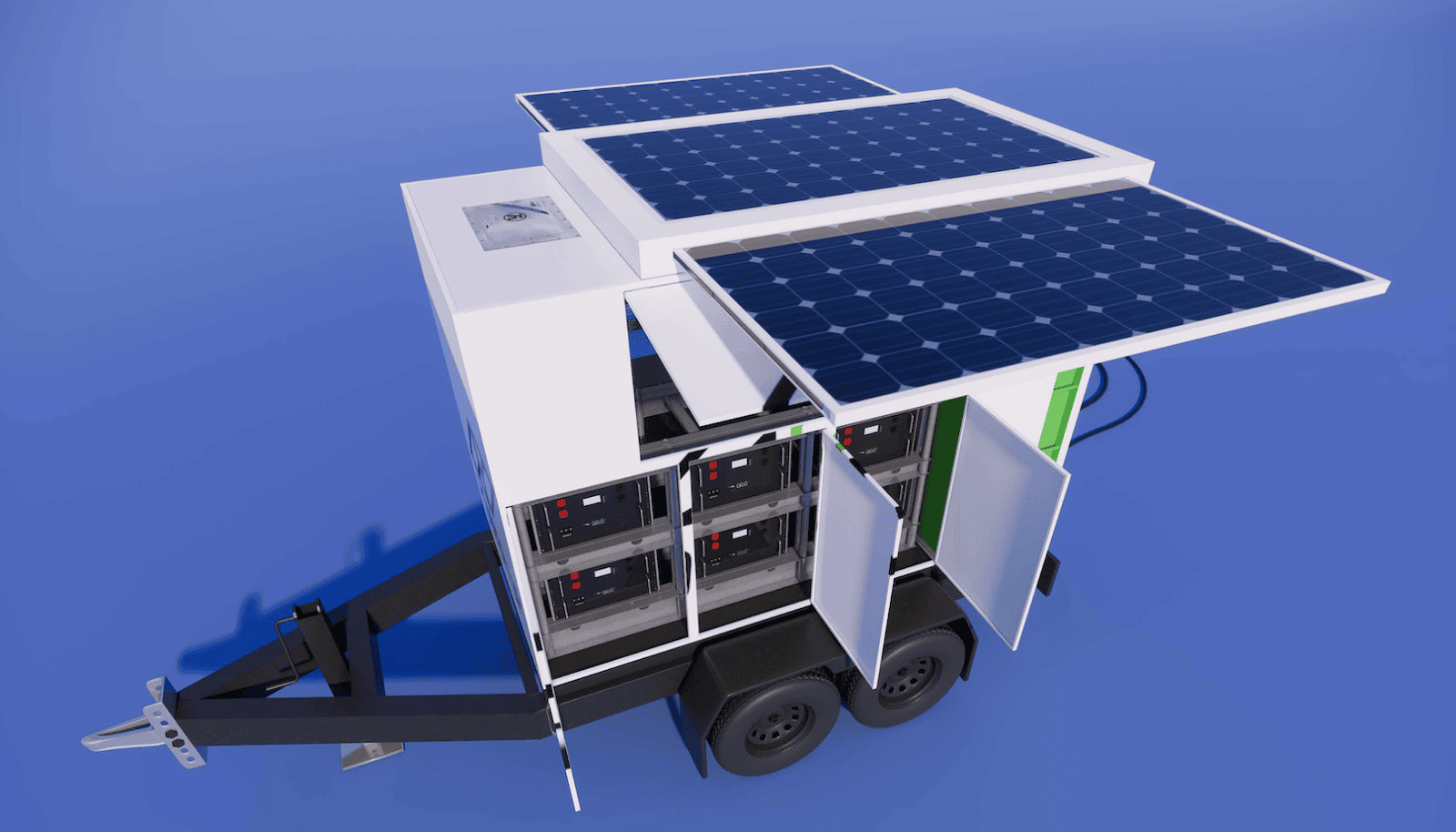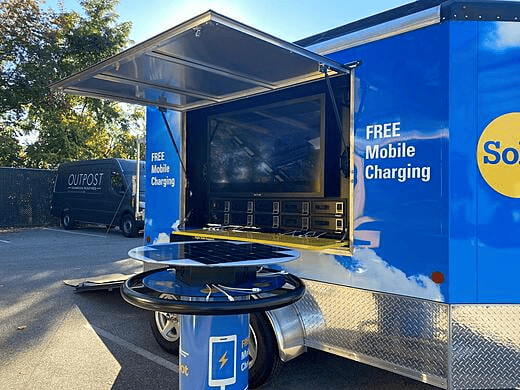Introduction
When climate disaster strikes, reliable access to power is critical. Enter the Green Grid Trailer, a High-Tech Trailer designed to deliver green power to areas hit hard by environmental catastrophes. This innovative solution harnesses renewable energy sources to provide electricity when traditional power grids fail, playing a pivotal role in sustaining communities during their most vulnerable times.

The significance of green power has never been more evident as the world grapples with the escalating impacts of climate change. Technologies like the Green Grid Trailer are at the forefront of combating these effects by offering sustainable energy alternatives that reduce carbon emissions and help stabilize local environments.
This article delves into the exceptional features, benefits, and real-life applications of the Green Grid Trailer. You will discover how this mobile unit is not just an emergency power source, but a versatile tool for resilience in the face of climate uncertainty. From its advanced solar panels and battery storage systems to its integration with green hydrogen fuel cells, the Green Grid Trailer represents a leap forward in eco-friendly energy solutions.
A Versatile Tool for Resilience
The Green Grid Trailer's adaptability allows it to serve various needs while maintaining a zero-emission footprint. Whether used as a neighborhood power station or a medical clinic, each deployment showcases its ability to adapt and serve various needs while maintaining a zero-emission footprint. Its advanced solar panels and battery storage systems make it ideal for prolonged use in remote areas where traditional power infrastructure is lacking.
One notable application is its integration with Charging Tower, made from hypo-allergenic stainless steel which provides a durable and easy-to-clean solution. These charging towers can be strategically placed in high traffic areas to ensure convenient access to power, further expanding the reach and impact of the Green Grid Trailer.
Privacy Policy
As with any technological innovation, privacy concerns may arise. However, you can rest assured that the Green Grid Trailer is designed with user privacy in mind. PowerUp Connect, the company behind this solution, maintains a strong commitment to user privacy and data protection. You can learn more about their privacy policy here, ensuring that your personal information and usage data are safeguarded.
1. The Green Grid Trailer: Revolutionizing Emergency Power Generation
1.1 Sesame Solar Nanogrid Trailer: A Breakthrough in Mobile Renewable Power Generation
The Sesame Solar Nanogrid Trailer marks a significant advancement in the realm of mobile renewable power generation. This cutting-edge solution aims to provide a reliable source of green energy during climate disasters, where traditional power systems have either failed or are inaccessible.
Features and Specifications of the Sesame Solar Nanogrid Trailer
● Solar Panels: Fitted with high-efficiency solar panels on its roof and retractable wings, the trailer can harvest solar energy even under less than ideal conditions.
● Battery Storage: The system includes batteries with approximately 40 kWh storage capacity, ensuring stored energy is readily available when needed.
● Green Hydrogen Fuel Cells: For continuous power supply during non-solar hours, the trailer employs an innovative fuel cell powered by green hydrogen, creating a consistent and sustainable energy source.
● Electrolyzer Technology: An onboard electrolyzer splits water into hydrogen and oxygen using electricity generated from solar power, providing an eco-friendly way to produce hydrogen fuel.
● Additional Functionalities: Beyond power generation, the unit can serve as a 5G Wi-Fi hotspot, run water purification systems, and even function as a Level 2 electric vehicle charger.
This amalgamation of technologies allows for maximized energy efficiency and resilience, providing a robust solution that is not only environmentally friendly but also highly practical for emergency scenarios.
Harnessing advancements in renewable technologies, the Sesame Solar Nanogrid Trailer offers an alternative to diesel generators which are known for their polluting emissions. Instead, it delivers clean electricity without contributing to atmospheric warming, aligning with initiatives like those from the California Air Resources Board that promote low-to-no emissions technology adoption.
For those interested in financing such sustainable solutions, there are options available that may facilitate acquiring these trailers for community or organizational use.
1.2 The Nanogrid Concept: Enabling Decentralized Energy Systems
A "nanogrid" is essentially a miniature version of the larger power grid. It is capable of operating independently or in concert with the main network. Here are some key benefits of deploying nanogrids during emergencies:
● Energy Security: With autonomy from the main grid, these systems ensure continuous power supply even if centralized infrastructure fails.
● Rapid Deployment: They can be swiftly deployed to disaster-stricken areas where rebuilding traditional infrastructure would take time.
● Carbon Emission Reduction: By utilizing renewable sources like solar energy and green hydrogen, nanogrids contribute significantly to reducing carbon footprint.
The concept behind nanogrids isn't just theoretical; it's already assisting real-world scenarios where traditional power infrastructures are either non-existent or incapacitated due to natural disasters.
If you're seeking similar portable charging solutions that cater to large crowds or demanding environments, consider exploring options like the Solar Charging Trailer. These trailers are equipped to charge 60+ cell phone devices, multiple wheelchairs, 2-way radios, portable battery packs, and many other applications that require power. The trailer also includes 20 RFID/PIN controlled lockers to store and charge devices.
Additionally, for larger-scale applications requiring substantial amounts of clean energy on-the-go, options like the Mobile Battery Energy Storage System are available.
1.2 The Nanogrid Concept: Enabling Decentralized Energy Systems
The Green Grid Trailer is a state-of-the-art mobile nanogrid system, designed to deliver clean electricity during emergencies. It stands out as a sustainable solution amidst the increasing frequency of climate disasters. By integrating renewable energy sources such as solar panels, advanced batteries, and fuel cells, the trailer ensures a reliable and eco-friendly power supply in disaster-stricken areas.
Nanogrid: A nanogrid is essentially a small-scale version of a traditional power grid but with a crucial distinction—it can operate independently from the main network. These self-contained systems are equipped with their own generation and storage capabilities, typically utilizing renewable sources like solar and wind.
The Sesame Solar Nanogrid Trailer exemplifies how mobile renewable power generation can be both practical and sustainable. Below are key benefits of deploying nanogrids in emergency situations:
Key Benefits of Nanogrids in Emergency Situations
● Enhanced Energy Security: Nanogrids provide critical support in scenarios where the central grid may be compromised. They ensure that essential services such as medical facilities, communication centers, and relief operations have uninterrupted access to power.
● Rapid Deployment and Response: During an emergency, time is of essence. Mobile nanogrids like the Green Grid Trailer can be quickly positioned and activated to meet immediate energy demands without lengthy setup times.
● Reduction in Carbon Emissions: Unlike traditional diesel generators which are highly polluting, nanogrids leverage clean energy technologies, contributing to a reduction in carbon emissions even while responding to emergencies.
In essence, the Green Grid Trailer is more than just an alternative power source; it's part of a transformative approach towards decentralized energy systems that prioritize sustainability even in the face of adversity. This adaptability not only addresses immediate needs but also aligns with long-term environmental goals by minimizing reliance on fossil fuels.
By providing energy independence through innovation, mobile nanogrid systems like the Sesame Solar Nanogrid Trailer play a pivotal role in crafting a resilient infrastructure capable of withstanding the unpredictable nature of climate disasters.
2. Advantages of Green and Sustainable Energy Solutions for Climate Resilience
Green Power and Sustainable Energy Solutions are crucial in the race against time to reduce the impact of climate change. These innovative technologies not only help decrease the amount of carbon released into the atmosphere but also play a vital role in developing Climate Resilience—the ability to handle and recover from climate-related events.
2.1 Reduction in Greenhouse Gas Emissions
One key advantage is the significant decrease in greenhouse gas emissions. Traditional energy sources like oil, coal, and natural gas contribute significantly to global warming due to high carbon emissions. In contrast, green power sources such as solar, wind, and geothermal energy produce minimal to zero carbon emissions.
2.2 Types of Green Power Sources
2.2.1 Solar Energy
The Green Grid Trailer, equipped with solar panels, harnesses sunlight to generate electricity without releasing harmful pollutants into the atmosphere.
2.2.2 Wind Energy
Wind turbines convert kinetic energy from wind into mechanical power. This renewable resource offers a viable alternative to fossil fuels.
2.2.3 Geothermal Energy
Geothermal systems utilize heat from below the Earth's surface to generate electricity or heat buildings.
2.3 Social and Economic Benefits
Beyond environmental benefits, sustainable energy solutions create social advantages by boosting local economies and promoting energy independence. For instance, jobs can be created in manufacturing, installing, maintaining, and servicing renewable energy technologies.
2.4 Reliable Power Supply in Remote Areas
Moreover, these renewable resources provide a reliable power supply even in remote or disaster-stricken areas where grid infrastructure may be damaged or non-existent. The Green Grid Trailer exemplifies this with its ability to deliver clean power autonomously during climate disasters.
2.5 Energy Storage for Uninterrupted Power
Energy storage facilities complement these green technologies by ensuring a steady supply of power even when sunlight or wind is not available. Batteries store excess power generated during peak production hours for use during periods of low production or high demand.
2.6 Transitioning Towards a Sustainable Future
Transitioning towards cleaner and more resilient energy systems is an imperative step towards future sustainability. With the right mix of green technologies like solar panels, wind turbines, geothermal systems, and energy storage facilities, we can build a climate-resilient future that benefits not just us but also the generations to come.
3. Overcoming Barriers to Adoption for Mobile Nanogrid Systems
Mobile nanogrid systems like the Solar Charging Trailer offer significant benefits, but there are challenges that may hinder their widespread use. It's important to understand and tackle these obstacles in order to improve climate adaptation and disaster preparedness.
1.Initial Costs: The upfront investment for a mobile nanogrid system can be significant, deterring individuals and small organizations from purchasing.
2.Technical Complexity: People may be intimidated by the perceived complexity of operating and maintaining such advanced technologies.
3.Regulatory Hurdles: Inconsistent regulations across different jurisdictions can complicate the deployment of mobile nanogrids.
4.Market Awareness: Limited awareness among potential users about the benefits of nanogrid solutions can slow market penetration.
5.Infrastructure Compatibility: Existing energy infrastructure may not be readily compatible with new mobile nanogrid systems, requiring additional modifications or upgrades.
Encouraging Investment through Policy and Incentives
To overcome these barriers, specific policy measures and financial incentives could be implemented:
1. Subsidies and Grants: Governments could offer subsidies or grants to offset the initial cost of acquiring a mobile nanogrid system.
2. Tax Credits: Introducing tax credits for individuals or businesses that invest in renewable energy technologies can make these solutions more financially attractive.
3. Educational Programs: Investing in educational initiatives to demystify the technology for end-users can increase acceptance and utilization rates.
4. Standardizing Regulations: Streamlining regulatory requirements across regions would facilitate smoother implementation of mobile nanogrids.
5. Public-Private Partnerships (PPPs): Encouraging PPPs can lead to innovative financing models, making the technology accessible to a broader audience.
By addressing these barriers through strategic policies and incentives, stakeholders can speed up the adoption of mobile nanogrid systems like the Green Grid Trailer. These actions will not only promote climate resilience but also pave the way for a sustainable energy future free from reliance on traditional power sources.
The Future of Emergency Power Technologies: Towards a Resilient and Decentralized Grid Infrastructure
The direction of emergency power technologies is being significantly influenced by several emerging trends. Digitalization, electrification, and grid decentralization are not just buzzwords but pivotal elements that will define the Future of Emergency Power Technologies.
The Role of Digitalization
Digital tools and technologies are enhancing the performance and monitoring capabilities of energy systems. With real-time data analysis, predictive maintenance, and smart energy management systems, emergency power solutions like the Green Grid Trailer can operate more efficiently and reliably. The integration of Internet of Things (IoT) devices allows for seamless communication between various components within a nanogrid, ensuring optimal energy distribution and usage.
The Impact of Electrification
The shift towards electrification is crucial in reducing reliance on fossil fuels. Electrified systems are more adaptable to renewable energy sources, making them ideal for emergency scenarios where sustainability is key. As seen with the Sesame Solar Nanogrid Trailer’s use of solar panels and green hydrogen fuel cells, these technologies ensure a continuous supply of clean energy.
Grid Decentralization
Decentralization empowers local communities by providing them with individualized power generation capabilities. This model mitigates risks associated with large centralized grids that can fail during disasters, leaving vast regions without power. Decentralized grids can quickly adapt to changing conditions and provide targeted support where needed most.
Collaboration Between Sectors
Building a resilient grid infrastructure requires concerted efforts from both public entities and private organizations. Public policies must support the development and deployment of advanced emergency power technologies. Simultaneously, private companies should strive to innovate while making these technologies accessible and affordable.
Public Sector Contributions:
● Legislations incentivizing renewable energy adoption
● Grants for research in sustainable power solutions
● Standards for safety and interoperability in emergency power equipment
Private Sector Initiatives:
● Investment in R&D for cutting-edge technology
● Partnerships with governments for pilot projects
● Educational programs to raise awareness about sustainable emergency power systems
A synergistic approach ensures that advancements in emergency power not only address immediate needs but also contribute to long-term sustainability goals. By prioritizing resilience through innovation, society can better prepare for unforeseen climate-related events while advancing towards an inclusive energy future.
Case Studies: Realizing the Potential of the Green Grid Trailer in Diverse Scenarios
Case Study 1: US Air Force and Comcast Corp.
The adoption of the Green Grid Trailer is not restricted to any particular sector. Companies as diverse as US Air Force and Comcast Corp. have integrated this high-tech trailer into their operations. The Green Grid Trailer has proven its versatility by serving as a neighborhood power station, communications center, and even a medical clinic, according to testimonials from these organizations.
Case Study 2: EnerSys
EnerSys, an international company that provides stored energy solutions, is another success story. They purchased Nanogrids for deployment by their customers, including large telecoms. This collaboration illustrates an essential point: the Green Grid Trailer is not only a solution for climate disasters but also a valuable asset for businesses seeking to reduce their carbon footprint and enhance their energy resilience.
Case Study 3: Jackson-Based Sesame
Over the last five years, nearly 60 Nanogrids have been sold by the Jackson-based company Sesame. This achievement demonstrates sustained interest and trust in this innovative technology over time.
Case Study 4: San Francisco Demonstration
In a live demonstration in San Francisco, the Green Grid Trailer showcased its multi-functionality by featuring a Level 2 electric vehicle charger. This event highlighted how the trailer can contribute to broader efforts towards electrification, extending beyond emergency power supply.
Testimonial: Hospitals Post-Hurricanes
According to a report on MarketWatch, solar and green hydrogen 'Nanogrids' are not only sustaining hospitals post-hurricanes but also providing clean water and mobile office communications. These real-life applications underscore the wide-ranging impact of this technology in diverse scenarios.
These case studies highlight the potential of the Green Grid Trailer in different contexts - from corporate settings to disaster-stricken areas. Each narrative emphasizes how this technology is capable of providing clean and reliable power where it's most needed, demonstrating its value in building climate resilience. The diverse range of applications indicates that the Green Grid Trailer can play a pivotal role in numerous scenarios, serving as a beacon of green power when disaster strikes.
Conclusion
The Green Grid Trailer is a big step forward in fighting climate change and solving energy poverty. Its innovative design helps bring clean energy to areas affected by Climate Disaster. By combining solar power, batteries, and green hydrogen fuel cells in one mobile unit, it shows how we can meet our energy needs without harming the planet.
It's important to learn more about sustainable energy innovations like this. Supporting projects like the Green Grid Trailer means investing in both technology and a future where communities can withstand challenges.
Here are some actions you can take:
● Understand the positive impact of renewable energy systems.
● Support and invest in clean technologies that improve disaster response.
● Collaborate with initiatives working on sustainable and inclusive energy infrastructures.
By doing these things, you're helping protect our environment and ensuring everyone has access to reliable, clean electricity. Creating a sustainable future requires collective effort, and your participation is vital in making it happen.
Frequently Asked Questions

